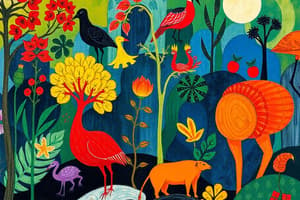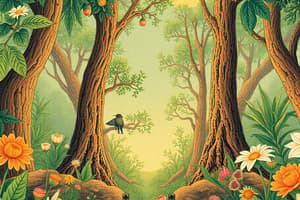Podcast
Questions and Answers
What is the primary benefit of maintaining ecosystem diversity?
What is the primary benefit of maintaining ecosystem diversity?
- Supporting human well-being through food and medicine
- Regulating the climate
- Preserving natural beauty
- Enhancing ecosystem resilience (correct)
What is the primary goal of sustainable development?
What is the primary goal of sustainable development?
- Meeting the needs of the present generation
- Promoting economic growth
- Conserving natural resources
- Eradicating poverty and hunger (correct)
What is the primary cause of climate change?
What is the primary cause of climate change?
- Burning fossil fuels (correct)
- Industrial agriculture
- Overpopulation
- Deforestation and land degradation
What type of biodiversity refers to the variety of genes within a species?
What type of biodiversity refers to the variety of genes within a species?
What is the primary importance of maintaining species diversity?
What is the primary importance of maintaining species diversity?
What is the primary consequence of habitat destruction and fragmentation?
What is the primary consequence of habitat destruction and fragmentation?
What is the trophic level of an organism that eats primary consumers?
What is the trophic level of an organism that eats primary consumers?
What is an example of a terrestrial biome?
What is an example of a terrestrial biome?
What is the term for a group of individuals of the same species living in a specific area?
What is the term for a group of individuals of the same species living in a specific area?
What type of symbiotic relationship involves one species benefiting and the other being harmed?
What type of symbiotic relationship involves one species benefiting and the other being harmed?
Flashcards are hidden until you start studying
Study Notes
Biodiversity
- Definition: Variety of different species of plants, animals, and microorganisms that live in an ecosystem or on Earth as a whole
- Types:
- Species diversity: Number of different species in an ecosystem
- Genetic diversity: Variety of genes within a species
- Ecosystem diversity: Variety of different ecosystems
- Functional diversity: Variety of roles and functions within an ecosystem
- Importance:
- Maintains ecosystem services (e.g. pollination, pest control)
- Supports human well-being (e.g. food, medicine, climate regulation)
- Enhances ecosystem resilience
Sustainable Development
- Definition: Meeting the needs of the present without compromising the ability of future generations to meet their own needs
- Principles:
- Social justice: Fair distribution of resources and opportunities
- Environmental sustainability: Conserving natural resources and reducing pollution
- Economic viability: Long-term economic growth and development
- Goals:
- Eradicate poverty and hunger
- Ensure access to education, healthcare, and energy
- Protect and restore natural ecosystems
Climate Change
- Definition: Long-term warming of the planet due to increased levels of greenhouse gases in the atmosphere
- Causes:
- Burning fossil fuels (e.g. coal, oil, gas)
- Deforestation and land-use changes
- Agriculture and livestock production
- Consequences:
- Rising sea levels and more frequent natural disasters
- Changes in precipitation patterns and weather extremes
- Loss of biodiversity and ecosystem disruption
Biomes
- Definition: Large, naturally occurring communities of plants and animals that occupy a major habitat
- Examples:
- Terrestrial biomes: Desert, forest, grassland, tundra
- Freshwater biomes: River, lake, wetland
- Marine biomes: Coral reef, open ocean, estuary
- Characteristics:
- Climate, vegetation, and animal species vary between biomes
- Biomes are dynamic and can change over time
Populations and Ecosystems
- Population:
- Definition: Group of individuals of the same species living in a specific area
- Characteristics: Size, density, growth rate, distribution
- Ecosystem:
- Definition: Community of living and non-living components interacting in a specific area
- Characteristics: Energy flow, nutrient cycling, species interactions
Trophic Levels
- Definition: Position of an organism in a food chain
- Levels:
- Producer (autotroph): Makes its own food through photosynthesis
- Primary consumer (herbivore): Eats producers
- Secondary consumer (carnivore): Eats primary consumers
- Tertiary consumer (apex predator): Eats secondary consumers
- Decomposer: Breaks down dead organic matter
Human Impact on Biodiversity
- Threats:
- Habitat destruction and fragmentation
- Overexploitation of resources (e.g. overfishing, logging)
- Climate change and pollution
- Invasive species
- Consequences:
- Loss of species and ecosystem disruption
- Decreased ecosystem resilience
- Negative impacts on human well-being (e.g. reduced food security, increased disease)
Symbiotic Relationships
- Definition: Close and often long-term relationship between different species
- Types:
- Mutualism: Both species benefit
- Commensalism: One species benefits, the other is not affected
- Parasitism: One species benefits, the other is harmed
- Examples:
- Coral-algae symbiosis
- Clownfish-sea anemone symbiosis
- Mycorrhizal fungi-plant symbiosis
Biodiversity
- Definition: Variety of different species of plants, animals, and microorganisms that live in an ecosystem or on Earth as a whole
- Types:
- Species diversity: Number of different species in an ecosystem
- Genetic diversity: Variety of genes within a species
- Ecosystem diversity: Variety of different ecosystems
- Functional diversity: Variety of roles and functions within an ecosystem
- Importance:
- Maintains ecosystem services (e.g. pollination, pest control)
- Supports human well-being (e.g. food, medicine, climate regulation)
- Enhances ecosystem resilience
Sustainable Development
- Definition: Meeting the needs of the present without compromising the ability of future generations to meet their own needs
- Principles:
- Social justice: Fair distribution of resources and opportunities
- Environmental sustainability: Conserving natural resources and reducing pollution
- Economic viability: Long-term economic growth and development
- Goals:
- Eradicate poverty and hunger
- Ensure access to education, healthcare, and energy
- Protect and restore natural ecosystems
Climate Change
- Definition: Long-term warming of the planet due to increased levels of greenhouse gases in the atmosphere
- Causes:
- Burning fossil fuels (e.g. coal, oil, gas)
- Deforestation and land-use changes
- Agriculture and livestock production
- Consequences:
- Rising sea levels and more frequent natural disasters
- Changes in precipitation patterns and weather extremes
- Loss of biodiversity and ecosystem disruption
Biomes
- Definition: Large, naturally occurring communities of plants and animals that occupy a major habitat
- Examples:
- Terrestrial biomes: Desert, forest, grassland, tundra
- Freshwater biomes: River, lake, wetland
- Marine biomes: Coral reef, open ocean, estuary
- Characteristics:
- Climate, vegetation, and animal species vary between biomes
- Biomes are dynamic and can change over time
Populations and Ecosystems
- Population:
- Definition: Group of individuals of the same species living in a specific area
- Characteristics: Size, density, growth rate, distribution
- Ecosystem:
- Definition: Community of living and non-living components interacting in a specific area
- Characteristics: Energy flow, nutrient cycling, species interactions
Trophic Levels
- Definition: Position of an organism in a food chain
- Levels:
- Producer (autotroph): Makes its own food through photosynthesis
- Primary consumer (herbivore): Eats producers
- Secondary consumer (carnivore): Eats primary consumers
- Tertiary consumer (apex predator): Eats secondary consumers
- Decomposer: Breaks down dead organic matter
Human Impact on Biodiversity
- Threats:
- Habitat destruction and fragmentation
- Overexploitation of resources (e.g. overfishing, logging)
- Climate change and pollution
- Invasive species
- Consequences:
- Loss of species and ecosystem disruption
- Decreased ecosystem resilience
- Negative impacts on human well-being (e.g. reduced food security, increased disease)
Symbiotic Relationships
- Definition: Close and often long-term relationship between different species
- Types:
- Mutualism: Both species benefit
- Commensalism: One species benefits, the other is not affected
- Parasitism: One species benefits, the other is harmed
- Examples:
- Coral-algae symbiosis
- Clownfish-sea anemone symbiosis
- Mycorrhizal fungi-plant symbiosis
Studying That Suits You
Use AI to generate personalized quizzes and flashcards to suit your learning preferences.




